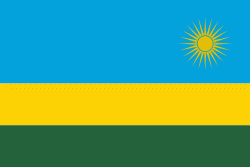National University of Rwanda (National University of Rwanda)
The National University of Rwanda (NUR; Kaminuza nkuru y’u Rwanda, Université nationale du Rwanda, UNR) was the largest university in Rwanda. It was located at -2.61611°N, 29.74278°W in the city of Butare and was established in 1963 by the government in cooperation with the Congregation of the Dominicans from the Province of Quebec, Canada. Its founder and first rector was Father Georges-Henri Lévesque.
When it was established, the NUR had three divisions (Faculties of Medicine and Social Sciences, and a Teacher Training College), 51 students and 16 lecturers. The university suffered badly during the genocide and had to close in 1994, reopening in April 1995. At that time English was introduced as a medium of instruction alongside French.
In 2013, along with all public higher education institutions in Rwanda, it was merged into the newly created University of Rwanda.
When it started in 1963 NUR was composed of three academic units: the Faculty of Medicine, the Faculty of Social Sciences and the Teacher Training College (ENS). At that time, it had 51 students and 16 lecturers. By 2005, the university had 8221 students and 425 lecturers. Important dates and facts are:
* November 3, 1963: Official opening of NUR
* May 12, 1964: Law establishing the NUR
* 1966: The National Institute of Education was created thanks to the UNDP and UNESCO: The Institute aimed at training and improving elementary secondary school teachers’ skills. It also aimed at implementing multidisciplinary pedagogical research.
* 1967: Creation of the University Extension as a unit with the mission to reflect NUR by its services to the people
* 1972: Creation of a research centre on pharmacopoeia and traditional medicine (CUPHARMETRA) in the Faculty of medicine. This became an autonomous body in 1980.
* May 1973: NUR, in conjunction with the Ghent Faculty of Applied Sciences put up a progressive training program for civil engineers specialized in building and set up a fore-project program in electro mechanic engineering.
When it was established, the NUR had three divisions (Faculties of Medicine and Social Sciences, and a Teacher Training College), 51 students and 16 lecturers. The university suffered badly during the genocide and had to close in 1994, reopening in April 1995. At that time English was introduced as a medium of instruction alongside French.
In 2013, along with all public higher education institutions in Rwanda, it was merged into the newly created University of Rwanda.
When it started in 1963 NUR was composed of three academic units: the Faculty of Medicine, the Faculty of Social Sciences and the Teacher Training College (ENS). At that time, it had 51 students and 16 lecturers. By 2005, the university had 8221 students and 425 lecturers. Important dates and facts are:
* November 3, 1963: Official opening of NUR
* May 12, 1964: Law establishing the NUR
* 1966: The National Institute of Education was created thanks to the UNDP and UNESCO: The Institute aimed at training and improving elementary secondary school teachers’ skills. It also aimed at implementing multidisciplinary pedagogical research.
* 1967: Creation of the University Extension as a unit with the mission to reflect NUR by its services to the people
* 1972: Creation of a research centre on pharmacopoeia and traditional medicine (CUPHARMETRA) in the Faculty of medicine. This became an autonomous body in 1980.
* May 1973: NUR, in conjunction with the Ghent Faculty of Applied Sciences put up a progressive training program for civil engineers specialized in building and set up a fore-project program in electro mechanic engineering.
Map - National University of Rwanda (National University of Rwanda)
Map
Country - Rwanda
 |
 |
| Flag of Rwanda | |
Hunter-gatherers settled the territory in the Stone and Iron Ages, followed later by Bantu peoples. The population coalesced first into clans, and then, into kingdoms. In the 15th century, one kingdom, under King Gihanga, managed to incorporate several of its close neighbor territories establishing the Kingdom of Rwanda. The Kingdom of Rwanda dominated from the mid-eighteen century, with the Tutsi kings conquering others militarily, centralising power, and enacting anti-Hutu policies. In 1897, Germany colonized Rwanda as part of German East Africa, followed by Belgium, which took control in 1916 during World War I. Both European nations ruled through the Rwandan king and perpetuated a pro-Tutsi policy. The Hutu population revolted in 1959. They massacred numerous Tutsi and ultimately established an independent, Hutu-dominated republic in 1962 led by President Grégoire Kayibanda. A 1973 military coup overthrew Kayibanda and brought Juvénal Habyarimana to power, who retained the pro-Hutu policy. The Tutsi-led Rwandan Patriotic Front (RPF) launched a civil war in 1990. Habyarimana was assassinated in April 1994. Social tensions erupted in the Rwandan genocide that span of one hundred days. The RPF ended the genocide with a military victory in July 1994.
Currency / Language
| ISO | Currency | Symbol | Significant figures |
|---|---|---|---|
| RWF | Rwandan franc | Fr | 0 |
| ISO | Language |
|---|---|
| EN | English language |
| FR | French language |
| RW | Kinyarwanda |
| SW | Swahili language |















